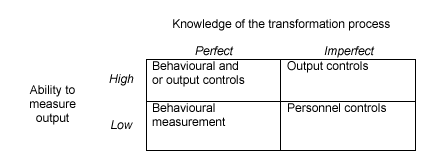Ouchi developed a model for helping to determine what types of controls are most appropriate for employees in different situations:
? Personnel controls, also known as clan controls, are based on fostering a sense of solidarity in the people who work for an organisation. If personnel believe in the objectives that the organisation is trying to achieve, then they will be motivated to work towards those objectives and will not require detailed supervision or control. Personnel controls include recruitment of people with the right attitudes, training and job design. These are closely related to appraisal systems based on inputs.
? Behavioural controls involve observing the employee – for example, the foreman on a production line watches the employees to ensure that the work is done as prescribed. Such controls are consistent with appraisal systems that focus on the behaviour of employees.
? Output or results controls that focus on measuring some aspect of work performed. Examples could include measuring the number of defective products. Appraisal systems based on results or outcomes are examples of output controls.
The type of control system that is appropriate depends on two variables – the ability to measure output, and the knowledge of the transformation process. Ouchi forms a matrix from these two that helps to determine what types of control system are most appropriate for a particular organisation:

Knowledge of the transformation process is low in situations where there is no obvious way to do a task. Those performing the task may have to learn on the job, rather than be provided with a detailed instruction manual showing them how to do it. This may occur in project-based work, for example, where each project brings new tasks and challenges to the project team.
In manufacturing industries, it is likely that it is easy to measure output, and knowledge of the transformation process is high – the tasks have been performed many times before. So behavioural or output controls are appropriate, and appraisal will focus on the behaviour of employees or on results and outcomes.
A situation where the knowledge of the transformation system is imperfect but measurement is easy might be a sales department. Management may not be aware of the exact processes involved by the sales team, and there may not be one ‘right way’ of making sales. However, measurement of sales is easy to do, so output controls may be used. The problem with this approach, however, is that it does not take into account external factors. It may be difficult to make sales in some markets, for example, and so appraising employees on results alone might be deemed unfair.
The ability to measure output may be difficult in certain activities, such as research work. Where people work in teams, measuring the output of the individuals within the team may be difficult. Some individuals may put in more effort than others, for example. If knowledge of the transformation process is also low, then the organisation may have to rely on personnel and clan controls. In such situations, the appraisal process may focus on traits.
LINKING APPRAISAL TO THE REWARD SCHEME
The appraisal process may be linked to a reward scheme whereby employees or managers earn some incentives, such as promotion or financial incentives if targets are met. Reward schemes were discussed in another article, ‘Reward schemes for employees and management’ (see Related links).
 ,我们将会及时处理。
,我们将会及时处理。